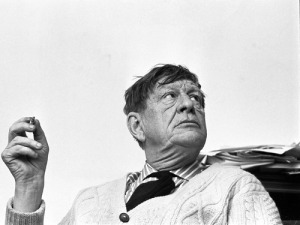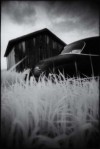“Poetry As Practice,” A Craft Essay
March 24, 2018
Cleaver Magazine published my craft essay, “Poetry As Practice,” earlier this year:
 POETRY AS PRACTICE
POETRY AS PRACTICE
How Paying Attention Helps Us Improve Our Writing in the Age of Distraction
A Craft Essay
by Scott Edward Anderson
In this lyrical essay on the writing life, Scott Edward Anderson shows how poetry can be more than a formal approach to writing, more than an activity of technique, but a way to approach the world, which is good for both the poet and the poem.—Grant Clauser, Editor
Walking in Wissahickon Park after dropping my twins at their school in Philadelphia, I find muddy trails from the night’s heavy rains and temporary streams running along my path. The fuchsia flowers of a redbud tree shine brilliantly against the green of early leafing shrubs. A few chipmunks scurry among leaves on the forest floor. Birdsong is all around me: I note some of the birds—if they are bright enough and close enough to the trail or I recognize their song—the red flash of a cardinal lights on a branch nearby; a robin lands on the trail ahead, scraping his yellow beak against a rock.
Observation like this helps feed my database of images, fragments of music, and overheard speech, which prepares my poetry-brain for the work of choosing words, putting them in a certain order, and forming phrases into lines, stanzas, and eventually entire poems.
Remembering a line I’m working on, I worry it like a dog with a bone, gnawing on the words, their syntax, imagery, sound or feel in my mouth and mind. Playing with the line, I’ll follow it until it leads somewhere or dumps me in a ditch, when I’ll file it away for another day. I’m paying attention to where the poem wants to go. READ MORE
The Hamline University English Department recently conducted an in-depth Q&A with me about two of my poems, “Naming” and “Villanesca.”
Here is a link to their blog, Hamline Lit Link, where it was posted: Read more

My poem “Villanelle on a Line Hated by Auden”
January 7, 2017

W.H. Auden
“September 1, 1939” is one of the most famous poems by W. H. Auden. He wrote the poem after learning the news of Hitler’s invasion of Poland at the start of World War II, published it a month later in The New Republic magazine, and reprinted it in his collection, Another Time, the following year.
Despite – or perhaps because of — rushing it into print, Auden appeared to dislike the poem almost as soon as it was published. As little as five years later, reprinting the poem in The Collected Poetry of W. H. Auden (1945), he cut the stanza with its most famous line, “We must love one another or die.”
“Between you and me, I loathe that poem,” he wrote to the critic Laurence Lerner, and resolved to keep it out of future collections of his work during his lifetime. He relented in 1955, allowing Oscar Williams to include it in his New Pocket Anthology of American Verse, but only with the proviso that the last line be edited to “We must love one another and die.”
Why did he hate this line – and the poem — so much? He claimed in a preface to the 1965 edition of his Collected Poems, “Some poems which I wrote and, unfortunately, published, I have thrown out because they were dishonest, or bad-mannered, or boring.”
In a Penguin anthology the previous year, the poem and four others were included along with a caveat: “Mr. W. H. Auden considers these five poems to be trash which he is ashamed to have written.”
What was it about the poem and, in particular, this line that Auden didn’t like? Was he embarrassed by its earnestness and sentiment, as some have suggested? Did he feel it was sappy and self-indulgent, as others would have it? Or was it “the most dishonest poem I have ever written,” as he put it?
And yet, the last line endures and the poem remains one of Auden’s most famous, surviving even today as one of the most eloquent pleas for empathy and peace in the face of totalitarianism. The poem even resurfaced as a touchstone for people in the wake of 9/11, as I have written elsewhere.
I wrote “Villanelle on a Line Hated by Auden” on 3 September 2014 as part of Jo Bell’s “52” experiment, and it was recently published in The Road Not Taken: The Journal of Formal Poetry.
Here is my poem, “Villanelle on a Line Hated by Auden”:
“We must love one another or die,”
The poet instructs, though doesn’t believe it.
“We must love one another and die.”
Revised to inclusive and on another try,
Then repudiated the poem, banning it.
He who must love another or die.
“Ours is not to reason why,”
Another poet said with the soul of wit.
Ours is to love one another. We die.
Changing a word makes meaning fly
To the far reaches of our minds and sit.
Must we, really, love one another or die?
Can we exist without knowing why–
Knowledge straining at the bit–
Until we can only love each other and die?
When we live without love, we die.
At least, those of us who desire it.
We must love one another or die.
We must love one another and die.
–Scott Edward Anderson
A Poet’s Work at the Condensery
July 12, 2010
I signed off of Twitter Saturday night with this note:
“Goodnight from my condensery…”
A friend saw it and wrote to ask what I meant by “condensery,” which seemed to have to do with making milk, not poems.
I was working, revising some poems, and meant “condensery” as a reference to the poet Lorine Niedecker.
It is an interesting choice of words, because condense means “to make denser or more compact; especially : to subject to condensation,” according to Merriam-Webster, which perhaps connotes compactness rather than concision. Concision, cutting away or making more concise, is probably closer to my method of revision. (I try not to make my poems more dense as I revise; and I rarely, if ever, can get as compact as Miss Niedecker did in her poems.)
Niedecker called her desk a “condensery,” in part to connote her process and in part to make it clear that, for her, her desk was a physical place of genuine, creative labor. Making poems is real work.
Here is Lorine Niedecker’s poem “Poet’s Work,” from which the phrase comes, in its entirety:
Grandfather
advised me:
Learn a trade
I learned
to sit at desk
and condense
No layoffs
from this
condensery
##
You can read more about Lorine Niedecker and her poetry at Poets.org
Her collected poems are available here: Lorine Niedecker: Collected Works.
Revise, revise, but when is too much?
June 25, 2009

Fallow Field by Joshua Sheldon
In fact, we were both inspired by the same image we saw, one summer driving south out of the Adirondack Mountains. A field, a car, a barn.
I wrote the poem in a quick burst of notes crawling around in the field as Joshua searched for the best angle to capture the scene on film. (See the result at left.)
Joshua’s photograph hangs on my wall and has adorned at least one book (not yet mine). My poem was published in Blueline, a journal published at SUNY Potsdam.
Some time over the years, after its publication, I revised the poem, excising what I thought were superfluous lines that made too fine a point in trying to draw a parallel between the subject’s experience — a woman who ended her marriage abruptly — and the landscape we found. The lines removed are underlined below:
Fallow Field
The old car is there,
where she left it,
out by the old shed,
breeding rust–obscured
from the roadway by the rye grass
that grows up all around.
Long triangular tentacles
blowing and bending
in the hot breeze, as
sunlight filters in
through gathering clouds.
By now the grass has worked
up into the engine block.
The car--an old
Chevrolet or Buick?–
no matter, it’s what
is planted now,
in this fallow field,
awaiting bulldozers.
They call this grass
“poverty grain,” and there’s
no small comfort in the fact
that it’s as tolerant
of poor soils
as she was of the poor soils
of her marriage.
On the day she left,
she packed her whole life
into an old grip: clothing,
framed photographs
of the children, her parents,
the salt cellar she’d bought
on her honeymoon in Rome.
While packing, she’d given
pause that her whole life
had become so
portable, where once there’d
been permanence. And now,
she blows and bends
like this rye grass
on a midsummer afternoon,
so far from home,
so far from the old shed
of her former self.
Joshua’s objections are outlined in the following email:
SEA: Ok, I’ve read and re-read the two versions of Fallow Field and again I want to express my support for the earlier version. There are three changes I’m aware of, two lines in the body and the ending. I don’t feel the two lines alter the poem much but the ending! The ending Scott! It flowed before, it let you down easy, it tied it all up like the well written present that it was.
I agree with Joshua that the old ending tied it all up neatly — just a little too neatly for my taste. I think the newer ending, with its abruptness, speaks more to the experience of the woman in the poem, and is more true to life.
Things don’t always end neatly. In fact, I suggest that most things don’t. Life is full of messy, sudden changes, especially in relationships.
Below is how the revised version of the poem reads today. What do you think?
Fallow Field
The old car is there,
where she left it,
out by the old shed,
breeding rust–obscured
from the roadway by the rye grass
that grows up all around.
Long triangular tentacles
blowing and bending
in the hot breeze, as
sunlight filters in
through gathering clouds.
By now the grass has worked
up into the engine block.
The car
is planted now,
in this fallow field,
awaiting bulldozers.
They call this grass
“poverty grain,” and there’s
no small comfort in the fact
that it’s as tolerant
of poor soils
as she was of her marriage.
On the day she left,
she packed her whole life
into an old grip: clothing,
framed photographs
of the children, her parents,
the salt cellar she’d bought
on her honeymoon in Rome.
While packing, she’d given
pause that her whole life
had become so
portable, where once there’d
been permanence. And now,
she blows and bends–
rye grass on a midsummer afternoon.
##

